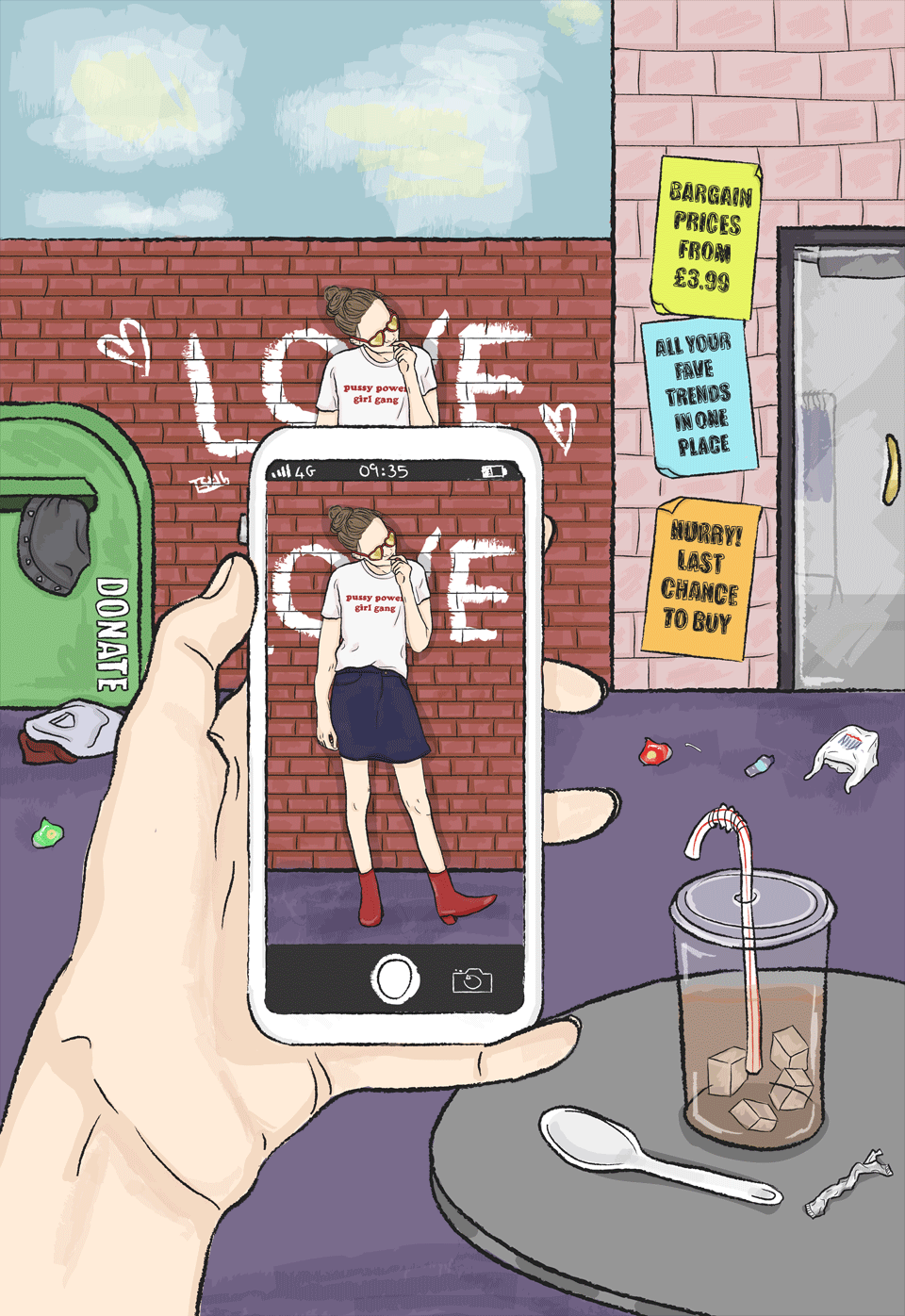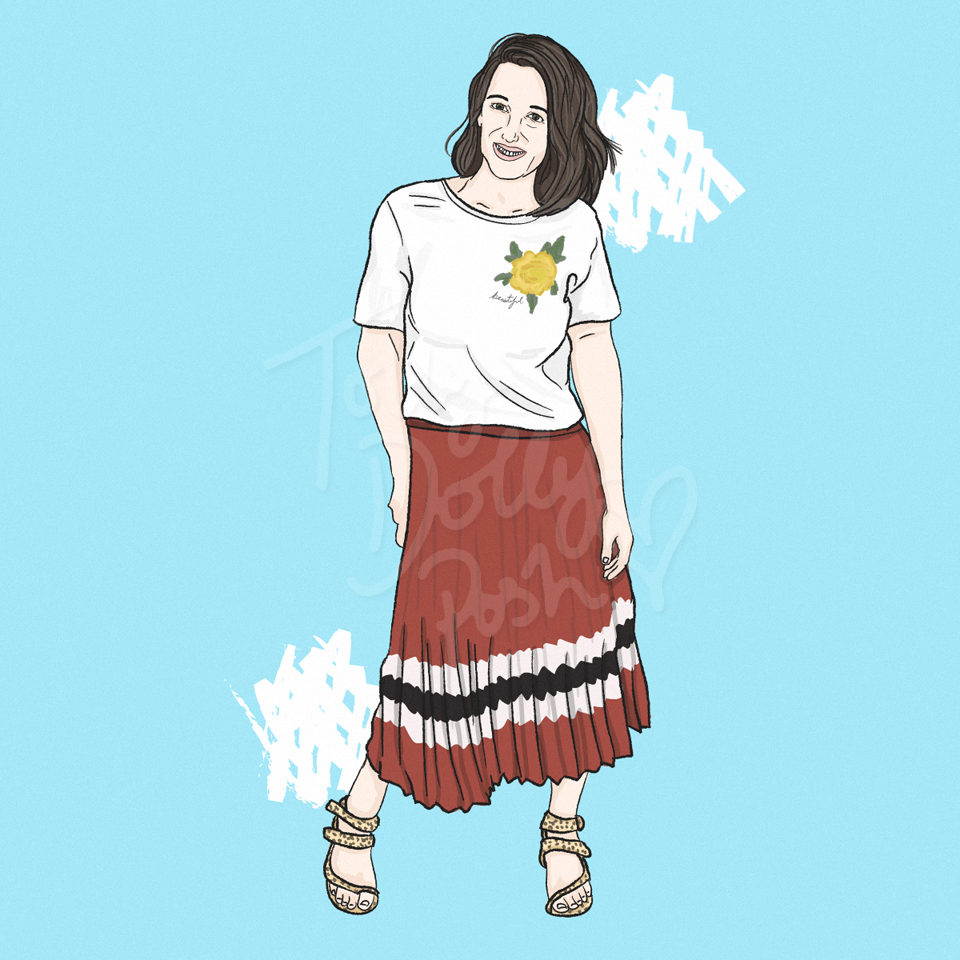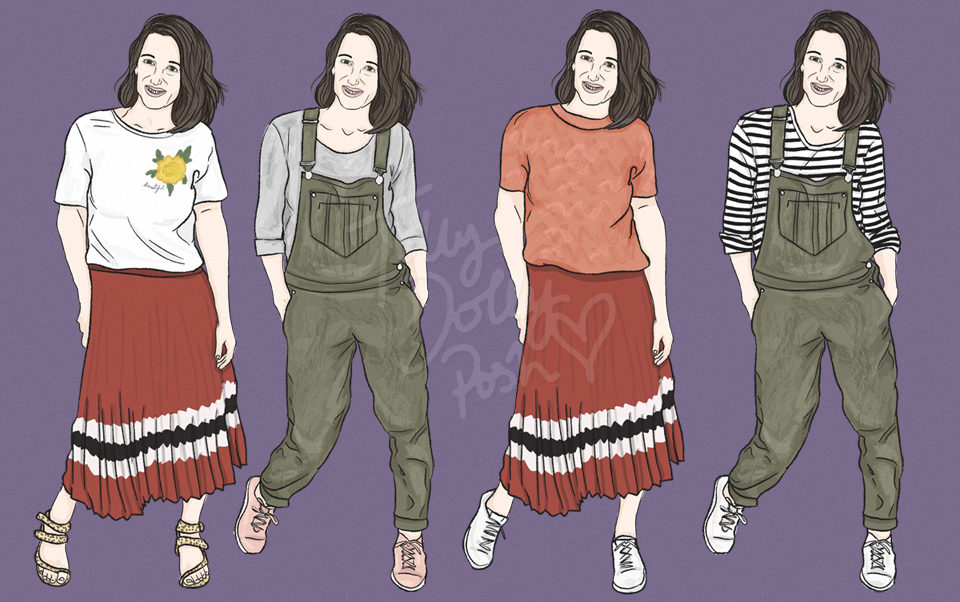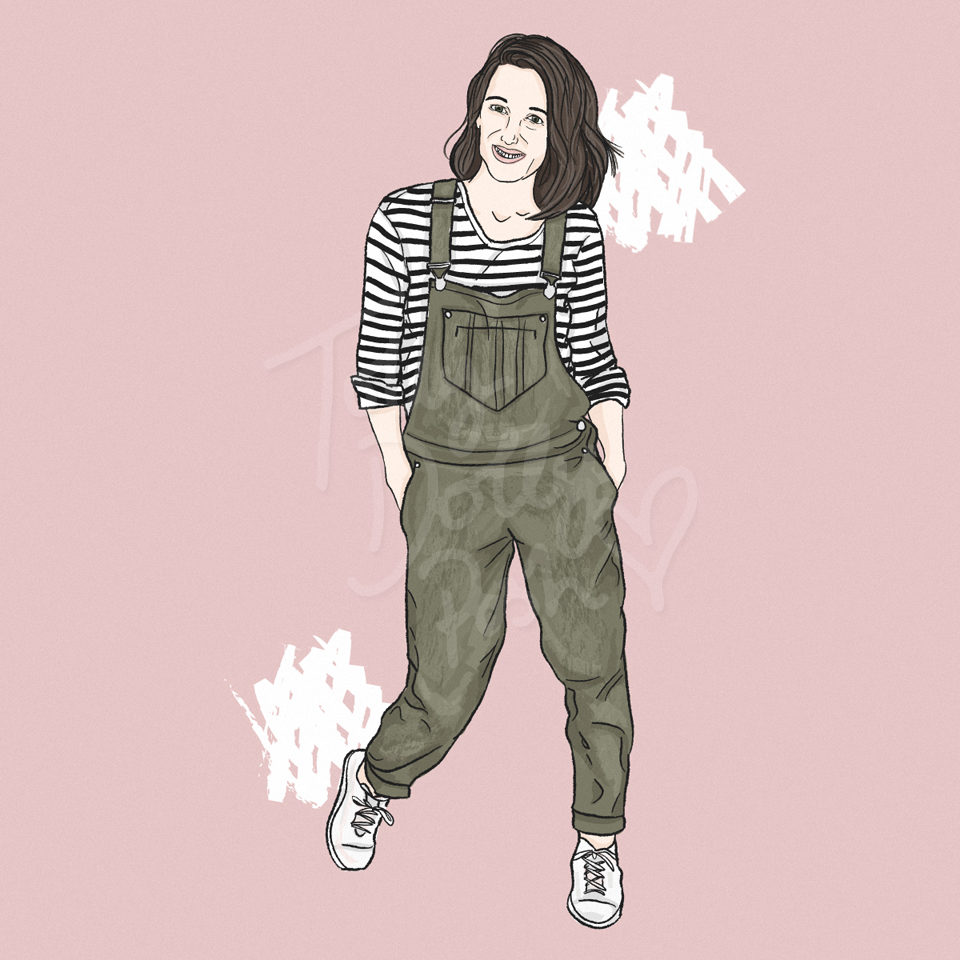Perhaps the timing of this piece is a little late with Black Friday and Cyber Monday having just taken over both physical stores and almost every inch of the internet. However, a new sale and discount frenzy are never far around the corner in current times and it’s clear that shopping habits are unlikely to slow down anytime soon, so, I expect this will stay relevant for a while still.

An experimental piece I illustrated on the theme of fast-fashion and consumption
A lot of us have heard the statistics by now; we know – according to statistics from the Environmental Audit Committee’s sustainable fashion hearing – that in the UK, 23% of our clothing stay sat in our wardrobes unworn and that on average we’re buying 27 kilos of clothes a year, per person. We know that this is having a detrimental effect on our planet and that according to a report by the IPCC (that gave me a fright, to say the least), and try to put a stop on irreversible climate change.
We know all of this to a certain extent, yet the idea of not shopping for new clothes to a lot of us, seems like a radical act, whether this be for brand new clothes or second-hand pieces which have already experienced a life with a previous owner. We can’t deny that there is a certain thrill when it comes to bringing a new material item into our life.
In fact, it’s so clear to so many of us that there’s scientific evidence suggesting it can cause a dopamine rush. Of course, this isn’t just with our clothes but it has to be said that other than essential purchases such as food, often our clothes are what we update most regularly. They are a tool, after all, allowing us to change how we wish to be perceived by others, express our personal beliefs and stand out in a sea of other people trying to fit in.
It’s why I love clothes so much. I can experiment and wear different pieces to suit my mood. I can mature and start to find confidence in wearing red suits or I can mix it up and wear My Little Pony socks with jelly shoes (you can hear more about that on the Pre-Loved Podcast episode, I recently spoke on).
Styling and creating outfits is and should be fun, whether it’s based on ethics and sustainability or not, so, I’m not about to enforce the idea of a hippie future for us all. The concept of not shopping that I’m going to discuss, shouldn’t be a vision of a nudist camp where we all grow and pick our own vegetables and blend our own nut milk every morning (however dreamy that may sound to some of us, perhaps bar the nudity). The concept of not shopping that I do want to discuss is far more realistic and one of which I think an awful lot of us could adapt our lives to if we just stopped being afraid of change.

Illustrations of Anna Firkins of @wearwhatsthere
This year, I made two changes. These two changes aren’t necessarily mind-blowing and they won’t change the world but they have made a big impact for myself and how I view my life. They are two very personal and actually rather incidental changes; in a way, I sort of fell into them.
Firstly, I decided to stop shaving my legs. I documented this decision a few months in after I could confidently say that it was a change I was embracing. It’s been almost a year now and I’ve done more than I ever could have imagined with a full display of leg hair. I went to my brother’s wedding without covering my legs; I went to the beach and skipped along the sand into the water; I went swimming at a public pool and held my head high. I did simple things with visible body hair on show that a year ago, would have felt extremely daunting to do (because I’d been trained to view it as disturbing and something to be ashamed of).
Secondly, I stopped eating meat. I’m not close to being a vegan yet and due to the fact that I eat fish every once in a while, I can’t technically call myself a fully committed vegetarian, however, my diet now fully consists of Quorn nuggets over chicken and a whole lot of bean curries to top up on a good amount of protein.
It hasn’t quite been a year yet but it has once again been a change that at first, seemed scary and not something I could see myself going all the way with. When I first started to cut out meat, I ate a sandwich with ham in it because I couldn’t be bothered to find an alternative – and now, I wouldn’t even question it; I would walk that bit further to find a vegetarian option from a different shop down the road.
The reason for referencing these personal changes is because I often see many people scared off by the idea of changing what they’re used to. Change in itself is always rather terrifying (the idea of cutting my hair short sounds like a bit of a nightmare) but surely change should always be easier to take head-on when we know the consequences of not changing and not evolving?

I adapted my shopping habits to become more sustainable because I’d started to educate myself on how my wardrobe was in part, contributing to the demise of our world. I choose the word “world” carefully because I was recently reminded of the fact that the planet itself will still very much be here, even if we can’t inhabit it ourselves.
If we know the statistics and we know that changing our ways could be beneficial, why does, for example, not shopping, seem so extreme? In theory, it’s not that much of a challenge. You see something you like in a shop window or on a clickable Instagram post and you just don’t buy it. Maybe one day, a few months down the line, you go back and buy it or you find a second-hand version but in the moment, when it’s just a spontaneous splurge, you resist.
In practice? You see something you like in a shop window or on a clickable Instagram post, you consider how you’re feeling that day and whether you deserve to just “treat yo’self” and then you step inside the shop door or click on the buy it now button; you try it on (or double-check the size guide), look at the price tag and do a little happy dance at how cheap it is, before adding it your basket and walking away smiling.
You smile for three days because that’s how long the dopamine rush of a new purchase lasts.

I would expect that a lot of us have had experience with both the theory and the practice. It’s far easier to resist buying something new when you have strict limiting factors already set in place. For example, a lot of us have tight purse strings that can’t be stretched as much as we’d like them to. But there are also times when they stretch a bit further and one purchase here and there won’t matter, so long as we don’t calculate what it’s all adding up to in the end.
And that’s just one side to it; the self-care and “treat yo’ self” culture, that 78% of you on Twitter said you find difficult to balance with a conscious consumer mindset.
I recently had an in-real-life conversation with the amazing Anna Firkins from @wearwhatsthere on Instagram (I’m specifying the fact it was an in-person conversation because did it really happen if I don’t?), who has been committed to not shopping for clothes for almost a year now. Her Instagram account is such a simple platform but it proves something really wonderful that there’s not nearly enough of, whether it be online or offline – we don’t need new clothes and we definitely don’t need them to look stylish or to express ourselves. If we choose wisely at the beginning, which Anna so clearly did (I’m a big fan of her khaki dungarees, as you can see from my illustrations), then it’s not necessary to rely on an influx of newness every few seasons, months, weeks or even days.
I recall once reading a blog post written by somebody who stated that they could never slow down their shopping habits or switch to more sustainable brands because they just loved shopping too much. The idea of being so attached to an activity that they admitted to knowing had cost to the environment, saddened me but I’ve seen this been said multiple times over since then, especially as more people have started to approach these sorts of topics and issues.

So, I asked Anna whether she’d had anybody respond to her not shopping challenge by saying, “I could never do it!”. Of course, the answer was yes but Anna could understand why it isn’t always easy.
For example, she hasn’t stopped shopping for her children because they’re growing and changing, and unsurprisingly, limiting new clothes for them isn’t exactly simple, or in fact, possible. We all have such different experiences and situations that we are faced with, which means it isn’t always as black and white as saying no or emptying your shopping basket. As Anna reminded me, sometimes we need a quick solution and that means having to put yourself first before the world or the people providing for us (in this case, garment workers).
Just like I can’t call myself a fully committed vegetarian, I also can’t say that I’m fully committed to not shopping, which means I can’t say it’s for everyone. It’s not a ‘challenge’ or a mission of mine simply because my purchases are few and far between and are almost always guilt-free (for example, unless it’s something I’ve been sent as a gifted item, I mainly only ever shop second-hand).
It’s to my belief that not shopping means doing some self-reflection and deep analysing within ourselves. It’s not about depriving yourself of nice things or material possessions that make us who we are but it’s about understanding why we choose to obtain these things in the first place. It’s similar to how I approached my personal decisions around body hair. I asked myself why I was doing it and I came up short. Could I love myself exactly how I am? Can we curate who we are and how we want to be perceived out of what we already have around us?
Do we need to be sold new collections every few months, picking out what strikes a chord with us? Or can we slow down? Can we find a middle ground where we’re not shopping but we’re in fact, investing?
Due to the amount of clothes I have in my wardrobe, adding anything new will never be a direct necessity but they will be a necessity for my personal growth and style evolution, whether I be strongly invested in fashion or not – and the fashion industry (and others) thrives on this little flaw within the connection between how we dress ourselves and our individuality.
Not shopping, or at least reducing the power that we give over to those, unfortunately, abusing the planet and our hunger for more isn’t radical. Taking the time to understand your choices, recognise what is really you and building from there, can be.
What do you think about not shopping? Is it radical? Do you think you could do it? Let me know in the comments!
Whilst I have you, it would be an honour if you could head on over to the UK Blog Awards and hit the heart ❤️ button on Tolly Dolly Posh Fashion in the Green & Eco category. I’d love to have my blog recognised with an award after six years of hard work. Thank you in advance!










